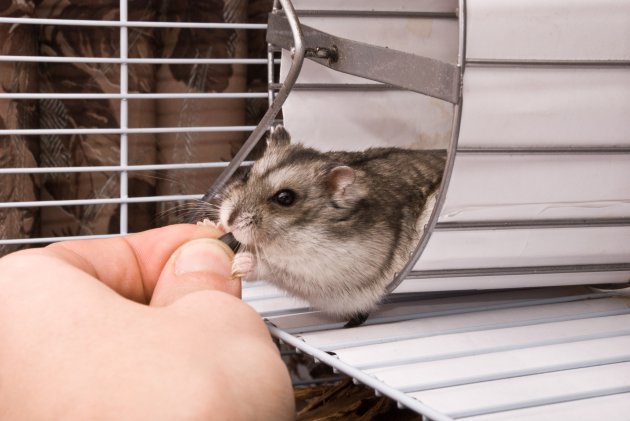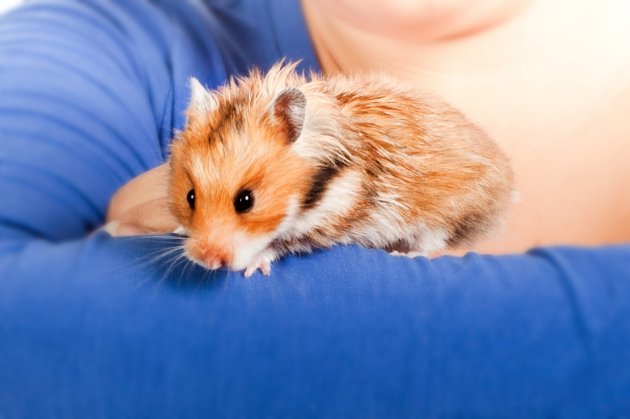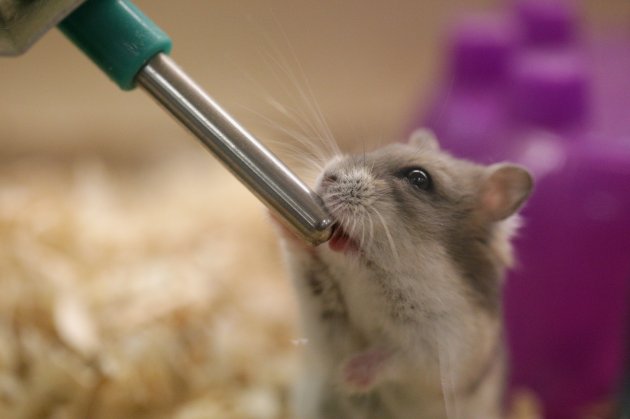A hamster’s small size makes it difficult to spot when they aren’t well. However, like all animals, hamsters do become sick for one reason or another. Knowing what these conditions are makes it easier for an owner to spot the signs, visit the vet, and thus get their pocket-pet back running around their wheel again.
1. Mange
Itchy and scratchy?
Mange mites cause itchiness in hamsters. Most commonly a mite called demodex takes up home in the hamster’s hair follicles. A small population of these mites is normal in hamster skin and usually causes no symptoms. But if the hamster’s immune system weakens, such as when fed a poor diet, it no longer holds the numbers of mites in check and they breed out of control. This is when symptoms develop.
Signs of mange include:
- Itching and scratching
- Inflamed, reddened skin
- Scaly, thickened skin
- Hair loss, especially over the trunk and rump
The vet can confirm the condition by looking at skin scrapings under the microscope.
Treatment includes the use of selenium shampoos or weekly applications of ivermectin. It’s also good to improve the hamster’s diet and make sure their cage is clean, to improve their general health and well-being.

2. Overgrown Teeth
Hamster teeth are similar to a rabbit’s, in that they grow through the animal’s life. Chewing wears the teeth down, but when the teeth grow faster than they wear down, this leads to overly-long crowns.
In extreme cases, if the incisor teeth (at the front of the mouth) overgrow they prevent the mouth closing or pierce the lip. Clues that a hamster has dental disease.
- Not eating hard foods
- Messy eating
- Weight loss
- Drooling
- A wet chin
A vet can trim the incisors with the hamster awake, but an anesthetic is required to check the cheek teeth. Once the teeth are back in shape, increasing the fiber in the hamster’s diet encourages them to chew and wear the teeth down naturally.
3. Weight Loss
Middle-aged or older hamsters sometimes lose weight, even though their teeth are fine. This is often due to liver or kidney disease, with both being common especially in Syrian hamsters.
Female hamsters, in particular, are prone to their organs becoming flooded with a fat called amyloid; whilst old-age kidney failure and cystic liver disease are also well-recognized conditions affecting hamsters.
Sadly, there is no treatment for liver and kidney failure in hamsters, except for making sure they are comfortable and have plenty of fresh drinking water available.

4. Wet Tail
The term ‘wet tail’ is often wrongly used as a general, descriptive term for diarrhea in the hamster. The reason is obvious, the diarrhea causes staining and wetness around the hamster’s rear.
However, true ‘wet tail’ is caused by a specific bacterium, Lawsonia, and mainly affects young hamsters aged 3 – 10 weeks old. The condition is serious and requires intensive nursing to give the youngster a chance at survival.
Treatment includes the use of antibiotics (doxycycline, trimethoprim-sulphonamides, or enrofloxacin are recommended) and fluids under the skin to prevent dehydration. Sadly, there is a high complication rate with problems such as rectal prolapse a potential risk, and euthanasia may be the kindest option.
5. Cancer
Sadly, young hamsters are prone to a form of cancer called lymphoma. This affects their immune system causing their lymph nodes to swell. Signs include marked swellings in the neck, armpit, groin, or belly.
There’s also a skin form of lymphoma that causes patchy hair loss and pigment patches to discolor the skin. Unlike other conditions linked to baldness, skin lymphoma causes a rapid deterioration in the hamster’s health and can prove fatal in just ten short weeks.
6. Heart Disease
Like any other animals, hamsters can suffer from heart disease. Indeed, it's estimated around 70% of elderly Syrian hamsters have some degree of heart disease. The signs include:
- Rapid shallow breathing
- Breathlessness
- Less time spent exercising and more resting
- Decreased appetite
Unfortunately, a complication is throwing blood clots that gum up the circulation. This leads to a worsening of the hamster’s health and, characteristically, suddenly going off their legs.
A hamster’s size makes them impossible to treat, since even the smallest dose of medicine is toxic relative to their tiny size.

7. Pyometra
Elderly female hamsters are at risk of a womb infection known as pyometra. Here the lining of the womb weakens and infection takes hold, then pus within the womb causes blood poisoning and septicemia.
The main signs include intense thirst, poor appetite, and a discharge from the vulva. When spotted early, antibiotics can help tackle the infection. However, not all cases will get better with antibiotic alone, whilst surgery to remove the septic womb is rarely successful.
8. Fractures
Those little legs are finer than match sticks. A hamster that takes a tumble from a table top or jumps from their owner’s hands is at high risk of breaking fragile bones.
Prevention is better than cure; by making sure the hamster is safe at all time and only handling them over soft surfaces such as a towel. Then if they are accidentally dropped they have a cushioned landing.
If the broken bone is not badly displaced and the hamster is otherwise well and eating, then a month’s box rest can give the bone time to heal. Remove their wheel (so they don’t go running) and temporarily restrict their living space to a shoe-box size so they rest up. However, a serious fracture causes pain and distress, which means euthanasia is necessary to prevent suffering.
9. Abscesses
An abscess is a pocket of pus that builds up under the skin as a result of a puncture or a scratch. An abscess looks like a swelling, and indeed sometimes a full cheek pouch is mistaken for an abscess.
Treatment involves lancing the swelling to let the pus out, along with a course of antibiotics to fight the infection from within.
10. Scent Glands
This last health problem is a case of mistaken identity that carries a good outlook. Commonly mistaken for skin cancer, adult male hamsters often develop two large dark patches on either side of their flanks.
Happily, these aren’t skin tumors but patches of pigment and hair loss caused by male scent glands. These produce secretions that advertise what a handsome fellow the hamster is. Far from being a serious problem, these are perfectly normal and nothing in the least to worry about. Some good news to end on!